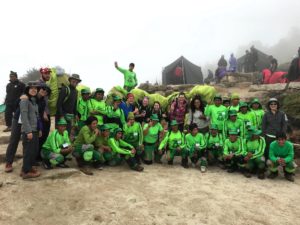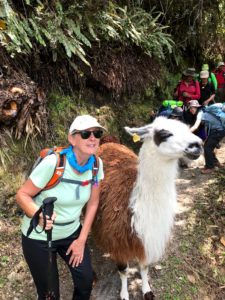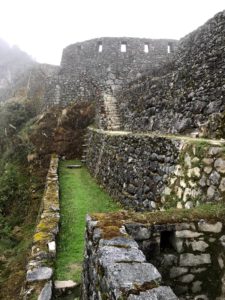April 5 was a day we had been anticipating since the mid-1980s: the day we would finally set foot on the famous Inca Trail to Machu Picchu.

We awoke that morning for our scheduled 4am pickup from our AirBnB in Cusco with great excitement and (for me) some trepidation. When you sign up for this trek, you are cautioned that this is not a walk in the park. The 27-mile footpath mostly consists of stones laid down by the Incas in the early 1500s, freed from the forest cover and repaired over the last 100 years. It has more steps than you can count, up and down, some of which are VERY steep. There are sheer drops where the trail seems to hang on the mountainside, making you wonder how the Incas could have built it. The trail ascends and crosses three high passes, hitting a top elevation of 13,779 feet. Shortness of breath, dizziness, and altitude sickness are not uncommon.
Last year we did over 750 miles of mountain hiking in our tour of the western US national parks, including to a few places in Colorado over 12,000 feet. But we’ve done very little hiking since early December when we visited Big Bend National Park in West Texas. In February, we did a challenging four-day trek in Torres del Paine in southern Chile (gorgeous!) but nothing much in the six weeks since. I wasn’t sure how much hiking mojo I would muster for the Inca Trail.
The Set-up
We’re talking about the Classic Inca Trail to Machu Picchu, which is just 27 of 25,000 miles of stone paved roads and trails that the Incas built to connect Cusco with the distant corners of their empire. The Classic Inca Trail is not the only trail to Machu Picchu, but it is today the most protected. In 2004 the Peruvian government enacted several restrictions to minimize damage to the trail and the many surrounding archeological sites. Only 500 hikers (including their support entourage) can start on the trail each day, and you must now book months in advance through an authorized agency. Although we like to be spontaneous, we booked the trek in early December so we wouldn’t miss out.
There were 16 hikers in our group, and it was a fun and intrepid group. Three or four had to overcome sickness along the way and still finished the trek. Most of our fellow hikers were young women, which matched our observation in the US last year that young women are really hitting the trails (yay!). Our group included an English family with interesting and intelligent twin 18-year-old daughters, five American travel nurses, three young Taiwanese women, and a Canadian farming couple from Saskatchewan.

Did you notice that I made a passing reference to a “support entourage?” Our group of 16 paying hikers had two guides, a chef and sous chef, and 20 porters. They worked really hard to guide us, encourage us in our moments of doubt/fatigue/nausea, cook amazing meals, serve us coca tea, and carry everything needed for the journey. We’ve never hiked with porters before, but apparently, this is the leading model now for the trek, since you can’t do it independently with all your stuff in your backpack and for some reason llamas are not being used on the trails. While we were happy to help provide employment for so many people, it was painful to watch our porters (ranging in age from 18 to 63) scurrying up and down the trail with enormous packs that weighed up to 65 pounds at the start of the trek. Their job was to beat us to our next destination, so that when we arrived at our lunch or dinner spot, everything would be ready and waiting for us. At the end of each day, they set up all the sleeping tents with our personal gear inside, our two “private” chemical toilets, a cooking area and a dining tent with large (folding) dining tables complete with table cloths. We were provided with abundant and delicious food and were very spoiled in general.
Our guides Ronald and Filio were amazing, and our chef Leonardo was a veritable magician. Our entire entourage were men from nearby villages, mostly Quechua-speaking with very little Spanish (except the guides, who spoke Spanish and English in addition to Quechua). They were all incredibly hard-working and did everything they could to make us feel comfortable and supported. One of their jobs was to cheer for each of us as we arrived at our campsite at the end of the day! They were real heroes, while we were just dilettantes with daypacks.
The Trail
There were many interesting human stories along the trek, but the real star of the show is the trail itself and the breathtaking landscape that envelops you throughout your journey. While most of us have seen pictures of Machu Picchu and have heard quite a bit about it, the trail is not often depicted as a major highlight in itself. But it is.
When the Spaniards arrived and started wreaking havoc with everything in the early 1500s, the Inca empire (called Tawantinsuyu) was at its high point. Centered on Cusco, Tawantinsuyu stretched about 1,200 miles north into southern Colombia and 1,200 miles south past Santiago, Chile. It was no small challenge to hold this vast territory together, roughly the size of the American midwest. As Peter Frost explains in his eloquent guidebook, Exploring Cusco, “There are thousands of Inca trails, but there is only one Inca Trail.” He continues:
Why? Few relatively short hikes in the world can offer such variety of scenery, so many staggering views, such a mix of jungle and high sierra. Certainly no other walk known to man will lead you along an ancient highway from one secluded ruin to another, each in a breathtaking setting, each almost perfectly preserved, offering shelter, solitude, and views that no pen or camera can ever adequately record. And of course, no other hike in the world ends with a climactic descent into Machu Picchu.
Walking the Inca Trail it is impossible to doubt that the entire experience was planned–there was nothing happenstance about the stunning combinations of scenic and man-made beauty. The Inca wanted those who walked this way to reel in awe as they crested the passes and rounded the corners. They designed the trail as a dramatic narrative, with a series of troughs, slow build-ups and climaxes, each greater than the last, until the stunning finale, when travelers looked down from Intipunku upon Machu Picchu, shining on its stone isthmus between two great peaks far above the Urubamba River.
Frost gushes further about the amazing landscape, but I’ll jump straight to his landing, which I adore:
The Inca Trail and Machu Picchu are rarely, if ever, considered in this light, as a complete work of art–perhaps because there was no single work of art among Old World civilizations on anything approaching this scale. And yet in this author’s view it was exactly that, rather like a gothic cathedral, with its intended purpose: to create a complete transformational experience of sacred landscape for elite pilgrims on the way to Machu Picchu, a sacred city.
These words ring so true to me. (Thanks Pete!) The Incas were brilliant architects, city planners, and engineers, highly attuned to and worshipful of the earth and the sky. They viewed the mountains as living beings. They carefully chose the setting for their pilgrimage trail and their sacred city. The results are stunning, and enduring, and to experience it, as the clouds shift dramatically around you, is a spiritual experience. We felt privileged to walk through several micro-environments in just 27 miles — dry grassy slopes sporting cacti, cloud forests boasting a variety of epiphytes, and mossy wet rain forests — and visit about a dozen astonishing Inca and pre-Inca sites alongside the trail.
Back to the Kaplans
OK, so let’s get back to the more mundane stuff, like how did we do with the hiking? The trail was definitely challenging. The stone steps often seemed endless, relentless, and unforgiving. There were many times when my knees, thighs, and hamstrings were aching–but not screaming. In hiking, as in childbirth, and in “impossible” work situations, although there are times when you think you can’t go on, you actually can, even for a long time. And, it’s surprising how you can get right back out there and do it again. This was true once again on the Inca Trail, so four months without much hiking worked out ok after all.
Also, fortunately, we didn’t have much trouble with the altitude, possibly because we spent almost a week hiking around Cusco and the Sacred Valley to acclimatize beforehand. That also allowed us to take several great hikes to Inca sites and other beautiful places nearby, including Sacsayhuaman, Qenqo, Ollantaytambo, Moray, Maras, Pisac, and the hills above Urubamba. That said, we certainly did our share of panting at the top of those passes after climbing hundreds of steep steps.
Bob was the fastest hiker in our group! He is a mountain goat and I love him for it, even when I’m swearing at him for making it seem so easy! I was the old lady of the group, but I’m happy to say that I too did really well and kept up with the youngest hikers: woohoo! The porters seemed to get a kick out of “la vieja” (old lady) coming into the campsite ahead of most of the pack (they whooped and chortled). This was a nice ego boost for me to realize that I’m not such a slow hiker after all; I’m only slow compared to my favorite and constant hiking companion.
While we definitely saw lots of people all along the trail, it wasn’t crazy crowded, although you had to be constantly on the alert to get out of the way of the amazing sprinting porters supporting all the various hiking groups. But all of that changed on the last day as we all converged for the grand finale. That last morning, we arose at 3am to walk a few hundred yards down to a checkpoint, like miners in the dark with our headlamps, so we could be the first in line, snatch up the limited bench seating, and maximize our time in Machu Picchu. By the time the checkpoint finally opened at 5:30am, more than 200 people had joined us there in the darkness. (Standing, ha! Laggards!) What a scene!
Released from our holding pen, we practically raced forward, afraid to pause to tie an errant shoelace or peel off a hot jacket, wary of the endless stream of highly excited people following single file behind us. Our shared objective: to make it to Intipunku (the Sun Gate) in an hour, just in time (maybe) to see the sunrise from behind the mountains and get our first glimpse of the city of Machu Picchu from above.
In the final approach to Intipunku the stairs are so steep and tall that you are forced to take it on all fours. (They call this section “the gringo killer.”) So: picture a procession of two hundred excited people initially strung out along the trail but now bunching together as the first people in line reach the steep stairs. We’re now packed tightly together two or three across, scampering frantically on all fours in a dim morning light to reach the top. One could get trampled like shoppers on “Black Friday.” Or fall backward and cause a domino effect of injuries. Yikes! It was a desperate and mad experience, and all for naught, because although we had a brief view of Machu Picchu in the morning fog as we reached the Sun Gate, it soon disappeared again in thick fog. I have to say that it was a bit anticlimactic after that frantic build-up, but after another 30 minutes of downhill hiking, we were actually standing in Machu Picchu: The Real Thing. It is incredibly beautiful, impressive, and fascinating, just like you know it will be. And thankfully, the clouds cleared up so we could see it.
We had paid an extra fee to climb Wayna Picchu, the iconic dome-shaped mountain that looms over Machu Picchu, so we only had about 90 minutes with our guides to visit the highlights on just one of three circuits laid out for visitors. I think the climb to Wayna Picchu was the hardest and most rushed hike of my entire life, complete with more all-fours gringo killer staircases, and I felt like I could fall off and die at almost any moment. But the views of Machu Picchu, the surrounding mountains, and down the valleys were just astonishing.
We were down from Wayna Picchu at 12:05, leaving just enough time to walk to the exit–and leave. Yes, leave. After 3+ days of vigorous hiking, a crazy, emotional pre-dawn scramble, and a grueling climb up Wayna Picchu, our allotted time for visiting Machu Picchu had already expired. I had run out of snacks and water, and I was literally ready to sob. We had waited for 35 years to come to this spot, and now it was over in a flash. We’d barely even seen it. We reluctantly joined hundreds of other visitors waiting in line in a cold rain to take the tourist bus from the main gate of Machu Picchu down a dozen switchbacks to the nearby town of Aguas Calientes (seemingly now trying to rebrand itself as Machu Picchu City).
Nearly three thousand people visit this remote site every day in two shifts, making it both an incredible boon to the local economy and a logistical headache. It was disorienting suddenly to be among hordes of tourists after living in the natural abundance of the Inca Trail where the loudest sounds were the songs of frogs and birds. And it was disappointing to have a strict time limit placed on our visit.

When we got back to Cusco, we considered going back to Machu Picchu to spend more time there, but balked at paying $400 for another six hours. That’s the cost of the entrance fee and round trip train fare, although it’s possible to cut it substantially by driving five hours on bumpy roads in a packed mini-bus, walking two hours along the railroad tracks to Aguas Calientes, and then retracing that route back again after visiting the site. Instead, we’re focusing on the beauty and deep satisfaction of having experienced the amazing Inca Trail and the incredible setting of Machu Picchu. And we have seen lots of other smaller but impressive and solitary Inca sites along the trail and in the Cusco region. We’ve learned a lot about, and been fascinated by, Inca and pre-Inca history and culture. So…maybe that’s enough?
Or maybe not. After resting and recuperating for a few days in Cusco this week, we’ve decided we’re up for more. On Sunday we’ll drive to a little village about three hours from Cusco so that on Monday morning we can start a five-day, 35-mile trek to Choquequirao, without guides, tablecloths, or chemical toilets! (Ok, we are caving in to comfort by hiring a mule to carry our stuff, along with a mule-driver, so we’ll only carry our daypacks.) The Choquequirao Inca site is actually larger than its famous sister city, but much less accessible to visitors as it is still two days hike from the nearest road. We hear and hope that visiting Choquequirao is a bit like visiting Machu Picchu before it hit the big time. And we’re building in time for a full day to explore the site at our leisure, with few tourists around, and Pete’s book in our daypack as our guide.
Here’s what Pete says:
Taken together, Choquequirao and its hinterland represent, just like Machu Picchu, a massive investment of time, labor, plus design, engineering and architectural skill; another large, mysterious, remote settlement that nobody in their right mind would build, but the Incas did.
Hasta luego, amigos!
With gratitude to Peter Frost, Exploring Cusco, 6th Edition Revised. Www.peterfrost.org (website under construction at this writing).




















What spectacular views!
Did you count the stairs with your fitbits?? ?
As I read this amazing entry on Sunday, you are visiting the Choquequirao Inca site. What a marvelous experience this has been for you and for those of us that follow you! All the photos are absolutely stunning, but I have to say that blue landscape is just breathtaking. Keep “tomando el toro (live in this case) por los cachos” you two! We will keep cheering your Intrepid adventures.
Hi Magdalena! We’re back from Choquequirao. Will post a blog about it soon. We’d love to meet you and Camilo somewhere. Asturias in June? England in July or August? Or join us for all or part of the coast-to-coast walk in northern England in September!
What a wonderful tale of the trail. Even the rushed feeling at the end will be an abiding memory….and the photos! There is one of Lorrie standing seemingly on the edge of a very big drop….whew. You are an amazing duo. Lots of love — hoping to see you in Europe in the fall somehow somewhere.
Sublime.. Crazy but sublime. Kudos.
To my favorite dilettantes with daypacks:
I’m thinking of you as you continue your greatest adventure and can’t wait for more stories and photos. Enjoy!